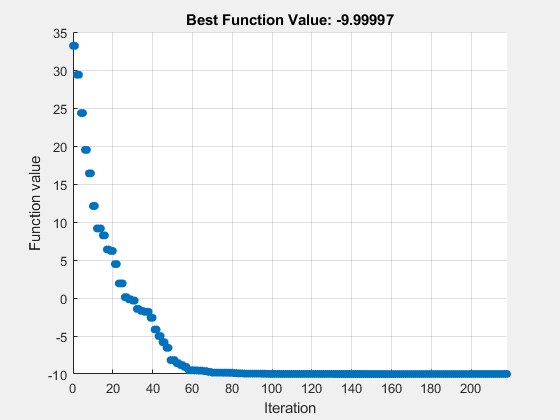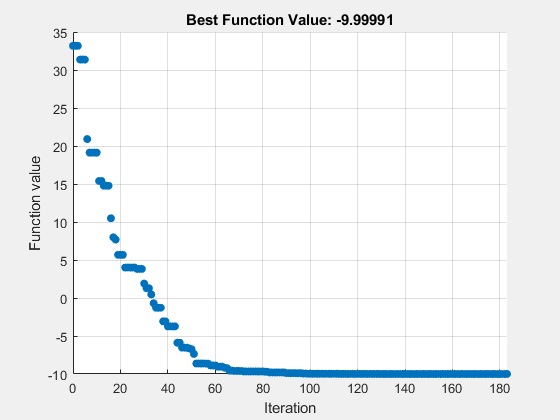Explore patternsearch Algorithms
Starting with R2022b, patternsearch has four algorithms:
"classic""nups"(Nonuniform Pattern Search)"nups-gps""nups-mads"
This example shows how the choice of algorithm affects a bounded problem with a nonsmooth objective function.
Objective Function
The objective function for this example is based on the 2-D ps_example function that is available when you run the example.
type ps_examplefunction f = ps_example(x)
%PS_EXAMPLE objective function for patternsearch.
% Copyright 2003-2021 The MathWorks, Inc.
f = zeros(1,size(x,1));
for i = 1:size(x,1)
if x(i,1) < -5
f(i) = (x(i,1)+5)^2 + abs(x(i,2));
elseif x(i,1) < -3
f(i) = -2*sin(x(i,1)) + abs(x(i,2));
elseif x(i,1) < 0
f(i) = 0.5*x(i,1) + 2 + abs(x(i,2));
elseif x(i,1) >= 0
f(i) = .3*sqrt(x(i,1)) + 5/2 +abs(x(i,2));
end
end
Extend the ps_example function to any even number of dimensions by creating pseudorandom offsets from the origin for every two dimensions, and adding the resulting objectives. See the code for the testps helper function at the end of this example.
Specify N = 10 dimensions, and set bounds of –20 to 20 for each component. Start patternsearch from the point x0 = [0 0 ... 0].
N = 10; lb = -20*ones(1,N); ub = -lb; x0 = zeros(size(lb));
Run Classic Algorithm
Set options to use the "classic" algorithm and to display the objective function values.
optscl = optimoptions("patternsearch",Algorithm="classic",PlotFcn="psplotbestf");
Run the optimization.
[xclassic,fvalclassic,eflagclassic,outputclassic] = ...
patternsearch(@testps,x0,[],[],[],[],lb,ub,[],optscl)patternsearch stopped because the mesh size was less than options.MeshTolerance.

xclassic = 1×10
-7.9575 5.9058 -8.5047 -5.5481 -8.9402 -2.8633 -7.5058 0.8919 -5.6967 2.9322
fvalclassic = -10.0000
eflagclassic = 1
outputclassic = struct with fields:
function: @testps
problemtype: 'boundconstraints'
pollmethod: 'gpspositivebasis2n'
maxconstraint: 0
searchmethod: []
iterations: 218
funccount: 3487
meshsize: 9.5367e-07
rngstate: [1×1 struct]
message: 'patternsearch stopped because the mesh size was less than options.MeshTolerance.'
Run NUPS Algorithm
Set options to use the "nups" algorithm. To obtain reproducible results, set the random seed.
optsnups = optimoptions(optscl,Algorithm="nups"); rng default % For reproducibility [xnups,fvalnups,eflagnups,outputnups] = ... patternsearch(@testps,x0,[],[],[],[],lb,ub,[],optsnups)
patternsearch stopped because the mesh size was less than options.MeshTolerance.

xnups = 1×10
-7.9575 5.9058 -8.5047 -5.5480 -8.9401 -2.8633 -7.5058 0.8919 -5.6967 2.9322
fvalnups = -9.9999
eflagnups = 1
outputnups = struct with fields:
function: @testps
problemtype: 'boundconstraints'
pollmethod: 'nups'
maxconstraint: 0
searchmethod: []
iterations: 183
funccount: 1827
meshsize: 8.5928e-07
rngstate: [1×1 struct]
message: 'patternsearch stopped because the mesh size was less than options.MeshTolerance.'
In this case, the "nups" algorithm reaches essentially the same solution as the "classic" algorithm while using fewer function evaluations.
Further Explorations
You can also try the "nups-gps" and "nups-mads" algorithms to see how they perform on this problem. Although you cannot always predict which algorithm works best on a problem, "nups" can be a good starting algorithm because it incorporates many adaptive features, making it likely to be the best algorithm.
Helper Function
This code creates the testps helper function.
function y = testps(x) N = numel(x); % Number of variables if mod(N,2) == 1 disp("Number of variables must be even.") return end strm = RandStream("twister",Seed=1); % Set Seed for consistency % Use RandStream to avoid affecting the global stream dsp = 5*randn(strm,size(x)); z = x - dsp; % Include random offsets y = 0; for i = 1:N/2 y = y + ps_example(z([2*i-1,2*i])); end end